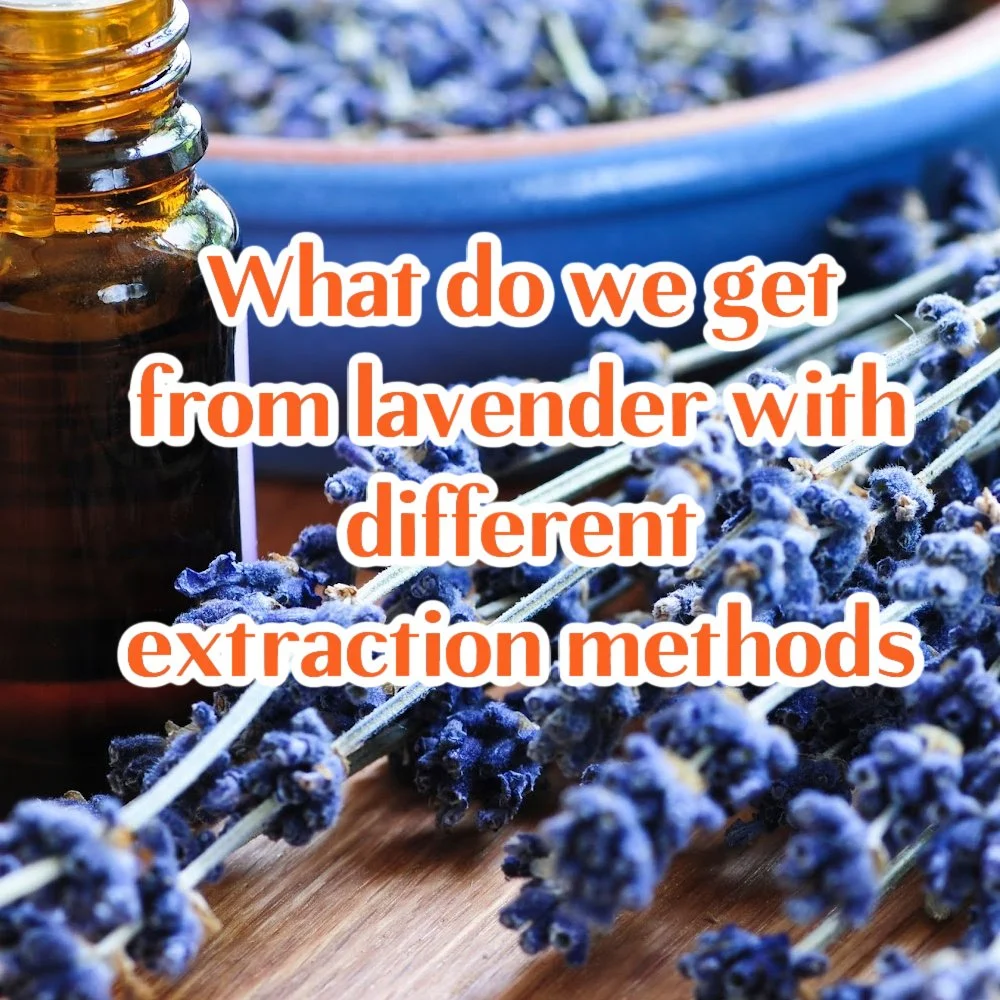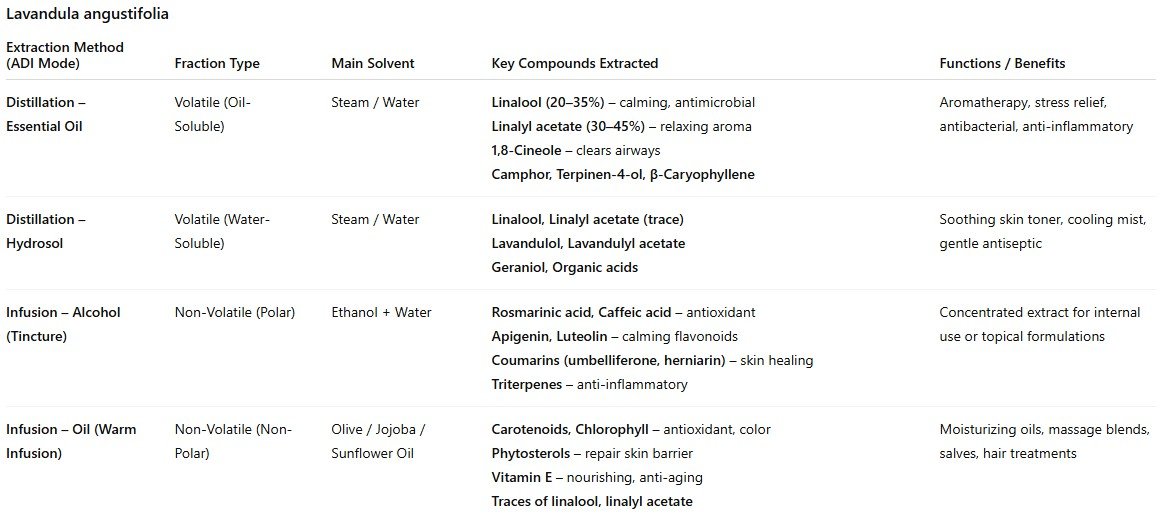Unlocking Lavender’s Chemistry: How ADI Captures the Full Spectrum of Phytochemicals
Lavender isn’t just a beautiful, fragrant flower — it’s a powerhouse of phytochemicals with calming, antimicrobial, and skin-soothing effects. But what gives lavender its therapeutic power isn’t one single ingredient — it’s the complex blend of volatile and non-volatile compounds working together.
To access this full spectrum, we need to use different extraction methods — and with ADI (Advanced Distillation & Infusion), you can perform both distillation and infusion to reveal every layer of lavender’s chemistry.
1. Lavender’s Phytochemicals: Volatile vs. Non-Volatile
Lavender contains more than 100 identified compounds, generally divided into two main categories:
Volatile compounds – light, aromatic molecules that evaporate easily (distillable)
Non-volatile compounds – heavier, stable molecules that remain in the plant after distillation (require solvent extraction)
Let’s explore what each method brings out.
2. Volatile Compounds: Extracted by Distillation
When you use ADI in distillation mode, steam or hydro-distillation separates the volatile fraction of lavender — the compounds responsible for its scent and immediate sensory effects.
Lavender Essential Oil (Volatile Fraction)
Main chemical constituents:
Linalool (20–35%) – calming, antimicrobial, and anti-inflammatory
Linalyl acetate (30–45%) – soothing, floral, contributes to relaxation
1,8-Cineole (eucalyptol) – clears the airways, antiseptic
Camphor (up to 1%) – mild stimulant, improves circulation
Terpinen-4-ol – antimicrobial and antifungal
β-Caryophyllene – anti-inflammatory, interacts with cannabinoid receptors
Lavender essential oil represents the volatile fraction — highly aromatic, potent, and concentrated.
Lavender Hydrosol (Aromatic Water Fraction)
Hydrosol is the water-soluble condensate collected during distillation.
It contains a tiny amount of essential oil and many water-soluble aromatic molecules such as:
Linalool and linalyl acetate (in trace amounts)
1,8-Cineole
Lavandulol and lavandulyl acetate
Geraniol, borneol, and small organic acids
Lavender hydrosol is gentler, pH-balanced, and perfect for skin toners, mists, and calming sprays — a great way to capture lavender’s essence in water form.
✅ With ADI, you can distill your own lavender hydrosol and essential oil simultaneously, precisely controlling temperature and capturing the delicate volatile compounds at their peak freshness.
3. Non-Volatile Compounds: Extracted by Alcohol or Oil
After distillation, the plant material still holds many non-volatile phytochemicals — the deeper, less aromatic compounds that contribute to lavender’s long-term benefits for skin and wellness. These can’t be distilled but can be extracted through tincturing or oil infusion.
Lavender Tincture (Alcohol Extraction)
Alcohol is a polar solvent, excellent at extracting water-soluble and some fat-soluble compounds.
A lavender tincture may contain:
Caffeic acid & rosmarinic acid – potent antioxidants and anti-inflammatories
Coumarins (umbelliferone, herniarin) – support wound healing and UV protection
Flavonoids (apigenin, luteolin) – calming, antioxidant, and neuroprotective
Triterpenes – contribute to anti-inflammatory and antimicrobial actions
Small amounts of volatile compounds (linalool, cineole) – if alcohol is high-proof
Tinctures are ideal for internal or concentrated topical use, where maximum chemical diversity and potency are desired.
Lavender Infused Oil (Oil Extraction)
Oil is non-polar, so it attracts fat-soluble molecules that alcohol cannot.
A lavender-infused oil (using olive, sunflower, or jojoba oil) typically contains:
Chlorophyll – antioxidant and anti-inflammatory
Carotenoids (β-carotene) – skin-nourishing and protective
Phytosterols – support skin barrier and reduce inflammation
Fat-soluble vitamins (A, E, K) – nourishing and moisturizing
Traces of essential oil components (linalool, linalyl acetate) – if infused warm
✅ With ADI in infusion mode, you can gently warm lavender in oil, maintaining the perfect temperature to extract lipophilic nutrients without degrading them. The closed system prevents oxidation, ensuring your oil remains vibrant and long-lasting.
4. Comparison: What Each Extraction Captures
5. Full-Spectrum Extraction with ADI
ADI (Advanced Distillation & Infusion) allows you to perform all these processes in one intuitive system.
Its patented dual-function design means you can:
Distill lavender to collect essential oil and hydrosol (volatile compounds)
Infuse lavender in oil to extract lipid-soluble nutrients (non-volatile compounds)
Combine your own distillate and infusion to create balanced, full-spectrum formulations
This versatility lets you capture lavender’s aroma, chemistry, and therapeutic depth — from soothing scent to skin-nourishing extract — all from the same batch of flowers.
6. The Takeaway
Lavender’s beauty lies in its chemistry — and with the right tools, you can experience it in its entirety.
Distillation reveals its spirit (aroma), tincturing captures its essence (bioactives), and oil infusion preserves its nourishment (lipid-soluble compounds).
With ADI, you can easily perform all three — unlocking lavender’s full phytochemical potential and bringing the art and science of herbal extraction into your own hands.


